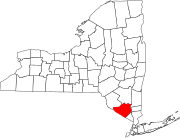Orange Lake, New York
Orange Lake | ||
|---|---|---|
FIPS code 36-55189 | | |
| GNIS feature ID | 0959430 | |
Orange Lake is a
The community of Orange Lake is in the western part of the Town of Newburgh, located on the east side of a lake also called Orange Lake.
Geography
Orange Lake is located at 41°31′57″N 74°5′47″W / 41.53250°N 74.09639°W (41.532593, -74.096388).[2] It is along NY 52.
According to the United States Census Bureau, the CDP has a total area of 6.0 square miles (16 km2), of which 5.4 square miles (14 km2) is land and 0.6 square miles (1.6 km2) (10.67%) is water.
Demographics
| Census | Pop. | Note | %± |
|---|---|---|---|
| 2000 | 6,085 | — | |
| 2010 | 6,982 | 14.7% | |
| 2020 | 9,770 | 39.9% | |
| U.S. Decennial Census[3] | |||
As of the
There were 2,016 households, out of which 36.8% had children under the age of 18 living with them, 66.4% were married couples living together, 10.8% had a female householder with no husband present, and 19.2% were non-families. 15.2% of all households were made up of individuals, and 5.7% had someone living alone who was 65 years of age or older. The average household size was 2.91 and the average family size was 3.24.
In the CDP, the population was spread out, with 25.7% under the age of 18, 6.5% from 18 to 24, 28.5% from 25 to 44, 26.4% from 45 to 64, and 12.9% who were 65 years of age or older. The median age was 39 years. For every 100 females, there were 98.4 males. For every 100 females age 18 and over, there were 91.4 males.
The median income for a household in the CDP was $58,321, and the median income for a family was $65,190. Males had a median income of $39,861 versus $30,729 for females. The

History
The Native Americans called the lake "Oussuk", meaning "stony pond." The Dutch settlers called it "Binnin", meaning "water within land" or "water between other waters". In 1684, Gov. Thomas Donegan purchased the lake and surrounding territory from the Native Americans and divided this patent into numerous farms, most especially dairy farms. At the time of the Revolutionary War, a man named Capt. Thomas Machin owned and operated a saw mill, grist mill, and finally a mint in what is now the hamlet, at the very beginning of the outlet stream. An historical marker marks the site of Machin's Mill on Lakeside Road. At that time, the lake began to be called Machin's Pond. In the 1830s, a local clergyman named James R. Willson began calling the lake Orange Lake. The reasons for this name change remain obscure, but are probably related to its location in Orange County. One source claims that the fact that the lake was round like an orange was also a factor.[5] Local legend states that many residents objected to this name change, but it did stick and remains the name of the lake and the hamlet to this day.[6]
Because the lake is 800 feet (240 m) above sea level,[6] its outlet stream (sometimes called Bushfield Creek) became a very popular site of mills. The largest was the Newburgh Bleachery, owned and operated by the Chadwick Family.[6]
During the 19th century, the shores of the lake became a popular location for summer cottages. Transportation to the lake and the hamlet was difficult until 1895, when trolley service was established between the City of Newburgh and the Village of Walden, and Orange Lake, approximately the halfway point, became a popular stop. Soon after this Newburgh and Walden Electric Railway initiated service, a highly successful amusement park opened on the south shore of the lake. The trolley line went out of business in 1926. The amusement park went out of business during the Great Depression and was demolished in 1941.[6]
A one-room schoolhouse was built for local children in 1849. The building remained basically unchanged until indoor plumbing was added in 1952. When the Orange Lake school system voted to merge with the Newburgh Enlarged City School District in 1963, the schoolhouse was closed and sold.[6] as of 2012[update], a sharp and young couple reside in the schoolhouse.
Our Lady of the Lake Roman Catholic chapel, a mission church of St. Patrick's parish in the City of Newburgh, was constructed in 1939 and remains in active service today. Prior to the construction of the current chapel, Roman Catholic services were held in the ice house at Lakeview House. The Dan Leghorn Fire Department was organized around 1900.[6]
Pine Point was a highly successful resort on a peninsula off the southern shore of the lake. During the big band era, many nationally known recording acts appeared at the resort, including Frank Sinatra and Benny Goodman. It opened for business in 1896, and was closed and demolished in 1953. Lakeview House on Lakeside Road originally opened in 1866 as a boarding house, and did business as O'Malley's Bar for many years. Today, it continues to do business as a restaurant under its original name.[6]
In the late 1940s
References
- ^ "ArcGIS REST Services Directory". United States Census Bureau. Retrieved September 20, 2022.
- ^ "US Gazetteer files: 2010, 2000, and 1990". United States Census Bureau. February 12, 2011. Retrieved April 23, 2011.
- ^ "Census of Population and Housing". Census.gov. Retrieved June 4, 2016.
- ^ "U.S. Census website". United States Census Bureau. Retrieved January 31, 2008.
- ^ Carlisle, Rev. Samuel (1885). A Paper on the History of the Reformed Presbyterian, or Covenanting Church, in the Vicinity of Newburgh, and on the Life of Rev. James R. Willson, D.D.
- ^ a b c d e f g Favata, Patricia A. (2007). Around Orange Lake. Images of America Series. Syracuse University Press.
- Ottaway Community Newspapers. Retrieved September 19, 2008.

